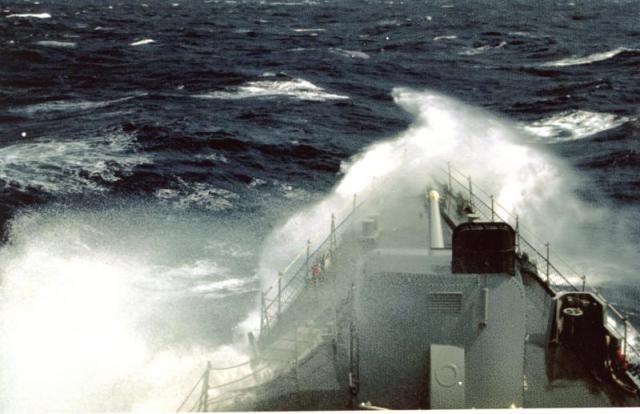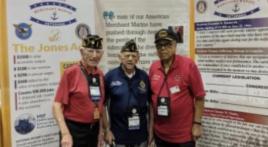A Memoir and Reflection on the Search for the USS Scorpion
Memorial Day 2011 was one of the most splendid and euphoric weekends of my life. My then 26-year-old daughter was about to graduate from the Harvard Graduate School of Education with a master’s degree. She had become a lover of learning at a great institution, a reflective student and a confident and capable young woman. My pride was stratospheric.
On a brilliant and sunny Friday afternoon, before the preliminary ceremonies, our family reverently walked through the Tercentenary Theatre, the pop-up outdoor auditorium with long rows of now empty folding chairs that appeared every year for the morning and afternoon exercises between the Widener Library and Memorial Church. We were all caught up with Harvard and its history, so mindful of great and universal thoughts, of academe, of excellence, achievement, of uniqueness in the world of learning. And this singular place under the giant trees — maples, elms, oaks, honey locusts. This place under the trees.
My family walked ahead of me as I paused. I looked back at the trees and wondered to myself which one was it? “What are you doing, Dad?” my son asked. “I’ll be there in a minute,” I said. But I was thinking about when I was in this place under those trees exactly 43 years ago. And I drifted back to a different me, when I was a sailor in the Navy, and it was Memorial Day 1968.
I was radarman then on the USS Julius A. Furer — the JAF as we called her — out of Newport, Rhode Island. She was a brand new destroyer escort with sophisticated and super secret sonar, rocket propelled torpedoes and a Tartar anti-aircraft missile. We had spent most of the winter training in Guantanamo Bay and, in May, we had just returned to Newport for rest and refit.
I had weekend duty onboard on Saturday and Sunday, May 25 and 26. With Memorial Day coming up, many crewmembers were away, taking a long weekend leave. According to the deck log that I retrieved from the National Archives, the ship received a message late on Monday evening that turned a quiet dockside respite into tense and rushed preparation. A submarine was overdue and missing, and the JAF and many others were going out to find her. It was an emergency underway, a Search and Rescue, and that was all we knew.
The Shore Patrol began rounding up sailors from the bars down on Thames Street — a rowdy section of historic downtown Newport — and taking them back to the ships at the Destroyer Piers. Long past midnight and into pre-dawn Tuesday morning, they met buses that were arriving at the Navy YMCA in downtown Newport, picking up the handful of crewmembers staggering back from an extra day’s leave. Earlier that evening, Petty Officer Paul Croteau, one of my shipmates in the Radar Gang, was in a hayloft in a barn in Keene, New Hampshire, with his girlfriend. Through some quick detective work and intuition, his mother tracked him down, shouting through the barn doors that someone on the ship called, and he had better get back to Newport in a hurry; she was getting underway in a few hours.
We left Newport at 0740 on Tuesday morning. Paul Croteau was one of the last crewmembers to come across the brow just before it was being removed. The news broke to the public on Monday’s evening news. A Skipjack-class nuclear attack submarine with 99 crewmembers on board was overdue and missing. She was the USS Scorpion, and she was on her way back to Norfolk from the Med after operating with the Sixth Fleet; her last stop was the Naval Base at Rota Spain, on the Atlantic side of Gibraltar. She missed all her daily check-ins since last Thursday, May 22. We left Newport at full speed with three other destroyers — in emergency sortie mode — with Radiomen and Yeomen helping to casting off mooring lines because so many bosun’s mates were on leave.
Our course was south-southwest to a rendezvous point off the Virginia Capes. I kept notes because I had a feeling that one day those notes would be important. By the Tuesday afternoon 16-2000 watch, we were 175 miles south of Newport. From my notes: “Wind up with heavy waves. Increasing seas promised through night. Now 20 ships on the Call Board. CO says at least 60 are in the search. Wind about 25 knots with 30 degree rolls. Course 195 Speed 25.”
Going through heavy seas at 25 knots tells you all you’d want to know about the urgency. My notes say the wind was 39 knots at 1800 on Tuesday, and “We bounce and ricochet. Visibility was going down.”
We had a large plastic garbage can tied around a stanchion in CIC, Combat Information Center, our dark, windowless workplace, lit by red lights and radarscopes. When we weren’t using the bridge urinal, this was our communal barf bucket. I was lying prone on my belly trying to tie the garbage can more securely when Mr. Pigeon, the 6-foot-6 Operations Officer, strode into Combat and looked down at me. He was puffing up gray clouds of smoke on a large cigar.
“Maginn,” he said loudly, “What are you doing down there?” Before I could answer, he stepped over me and went to the bridge, the cigar smoke trailing. It was the last funny moment for the next few days.
The radio nets were alive with news. An orange ball was sighted. Then the USS Campos Island recovered a life ring with no markings. At the end of that watch on Tuesday evening, we had reached the rendezvous Point Alpha off the Virginia Capes. Now, an armada of 37 ships was looking for Scorpion, 18 destroyers, 12 submarines, five submarine rescue ships, plus oceanographic research ships and airplanes and helicopters. We were all lined up from North to South spaced five to 10 miles apart, heading East. There were more sightings. A patrol plane spotted a marker buoy and then smoke flares on Wednesday morning. We joined our sister ships USS Talbot and Koelsch to race to the site. “Proceeding through heavy weather at 15 knots to rendezvous,” my notes say. “This could be it.” It was nothing.
Then our ship maneuvered to pick up on object in the water, a life jacket. Other reports were on the radio net: a floating wooden barrel, a metal cylinder, a fishing buoy with a red rag tied onto it. A broom. All the flotsam and jetsam in the water from the New Jersey coast to South Carolina was spotted and scrutinized by the searchers. On watch, the radar gang spent the hours staring at the black and green screen of the surface search radar, the tops of waves bouncing back as sea return, forming filigree lines all around us. And using our call signs, we would press the transmit button on the UHF: Brandywine, Brandywine, this is Austin City. Over and over again.
Meanwhile, all this time the seas were pounding us with perfect relentlessness. There were no meals after the first day. Just peanut butter and jelly or bologna sandwiches and coffee. There was no sleeping. Our racks were three high. We had straps to hold us down that went over our knees and shoulders if you could figure out how to use them. The ship was corkscrewing and rolling, rolling, rolling through the waves. We would rise up and then pound down and twist to the side with a shimmy and shake, and then roll and then rise up again and pound down.
The pound was like a blow, stopping sharply, decelerating with tremendous noise. The pinging of the sonar filled our sleeping compartment like audible smoke. It had a cycle of its own. De de, de de, de de, DE. Three pairs of eighth notes a third tone apart followed by a louder quarter note. A whole note rest and then De de, de de, de de, DE. Sleeping through that was just closing your eyes while bracing your arms and legs. On a particularly rough bounce, we could hear across the darkened berthing compartment… “Are you kidding?” “What was that?” We all seriously wondered if the ship would hold together.
We did that for three days. In between the active pinging of the sonar, the sonar guys called on the underwater telephone, known as Gertrude. Brandywine, Brandywine, this is Austin City. Hoping that someone down there would actually call us back.
The storm was historic. In mid-May, there had been a severe and deadly tornado outbreak across the Midwest and Southeast, producing 46 confirmed tornadoes —including two F5s — killing 75 people. I am sure we were sailing along with that storm system as it and we headed east across the Atlantic. We were clocking true wind speeds in the Force 9 and 10 range, making waves that reached the 01 level, 30-footers, as high as a three-story building.
On Wednesday at midnight, the radio nets said a ham radio operator in Virginia had picked up an SOS. My notes: “There are rumors now of saving Scorpion.” Years later, I read that it was a sickening hoax that had totally shattered the Scorpion’s families who had gathered at Norfolk.
On Thursday morning, I remember refueling underway next to an oiler in heavy, heavy seas. Rolling side to side, out of sync with the oiler, and rolling at different rates, watching the masts arcing back and forth, trying to catch up. By that time, many of the Atlantic fleet were called out. We were the first wave along with many other destroyers that had advanced sonar. Now, we were relieved and sent back to Newport. Remember, about a week at sea, hardly any sleep or food beyond white bread and coffee, shaken up like pebbles in a tin can, in a darkened room, the smell of vomit and body odor. We were exhausted. From my notes: “Ensign at half-mast. Memorial Day 1968.”
What we didn’t know on that Thursday Memorial Day morning was that by then it was already clear that the Scorpion was gone forever. Just one week before — on the 22nd— a P3B Orion patrol plane from the Azores had been tracking a Soviet Yankee class ballistic submarine when its sonobuoys detected a series of atypical noises. That report was sent to SubLant and became an important clue to the chief scientist in the Navy’s Special Project Office who, by Monday afternoon was already searching the Atlantic.
John Pina Craven led the search for the submarine Thresher in 1963 and recovered a missing hydrogen bomb off Spain in 1966 using ocean search theory based on Bayesian statistics. Bayesian statistics uses subjective guesses from experts to frame a map of probabilities that can be remarkably accurate. Curiously, the vast and secret underwater Sound Surveillance listening system—SOSUS—that ringed the North and South Atlantic specifically designed to detect Soviet submarines reportedly heard nothing. But by mid-week, Craven had hurriedly collected and analyzed underwater acoustic patterns found by happenstance from an oceanographic research outpost in the Canary Islands, manned by a professional friend of his. The data revealed eight separate explosions that lasted for three minutes and ten seconds. But they could have come from anywhere. What Craven needed was another source to get a fix. Through luck alone, that data came from two separate fuzzy hydrophone records collected from an Air Force base near Argentia, Newfoundland, discovered by the acoustic team at the Naval Research Laboratory. The sounds were triangulated, and they met more or less on the intended rhumb line course of the submarine. They were the sounds of the Scorpion as she broke up—compartment by imploding compartment—less than 400 miles along its way toward Norfolk.
The search for a reason began immediately. Unexplained submarine losses are dissonant, to say least, because they could hide a potentially fatal flaw for all submarines. That summer July, August, September 1968, an oceanographic research ship searched the site of the first explosion and was finding nothing. At the same time, Craven created a Bayesian probability map based on the acoustic pattern of explosions. The map revealed a remarkable first clue as to what might have happened. The submarine was heading east back to the Straits of Gibraltar, not west to Norfolk. A submarine turns 180 degrees like that to trigger fail-safe devices on torpedoes that “run hot”—their propulsion systems activated—while still on board. The idea of fail-safe was to prevent a torpedo from coming back to the ship that launched it, but it also shuts down the motors on hot runners, a not uncommon phenomenon on submarines. Despite the 180-turn, something happened, something had gone wrong with a torpedo that was running hot, and there was an explosion. At least, that’s what Craven believed.
But the Navy believed differently. Hot running torpedoes don’t explode inside submarines. Torpedoes have to strike an object at speed to detonate. Something wasn’t right.
Using probability theory and conjecture, the research vessel found the wreckage of Scorpion at 11,000 feet at the end of October, almost five months after she was lost. Photographs didn’t reveal much except that the boat was in two halves, its sail and propeller and shaft separated from the pieces of the hull. There were no clues as to what might have happened.
In January 1969, a Navy court of inquiry concluded that the cause of the Scorpion’s loss could not be “ascertained from any evidence now available.” The report posited several potential causes including improperly operated trash disposal units, gas leaks, broken hydraulic lines, and the possibility that an errant, hot-running torpedo was actually launched and came back to hit the ship, despite lack of visible evidence. The idea that there was a weapons accident onboard was not considered possible. Remember, torpedoes don’t explode inside submarines.
Later, a theory grew out of the idea that a Soviet submarine was operating nearby and, just like that Tom Clancy novel, the Soviet sub sank the Scorpion. In fact, there were no submarines nearby, and it was later determined by another deep-dive expedition that there was no sign of any external hits. That story persists to this day despite the obvious fact that World War III did not start in May 1968 nor have any of the thousands of would-be participants in this supposed cover-up ever come forward and spilled their beans.
And so the matter remained for years. In the mid-1980s, Robert Ballard’s acclaimed discovery of the Titanic using the Alvin submersible was actually a side trip from a mission for the Navy to survey the wreck of the Scorpion to check if the nuclear reactor or its two nuclear-tipped torpedoes were leaking, or if they were still, in fact, there. Other than that, the uncertain fate of the submarine remained significant only to the families and those who still wondered what happened.
But then, capricious fortune enters the story again. In 1993, to mark the 25th Anniversary of the loss of the Scorpion, the Navy re-published the Court of Inquiry findings as well as video footage taken by Ballard of the wreck. These documents found their way into a story along with Craven’s theory about a torpedo explosion that was carried by the Chicago Tribune. By sheer chance, a retired engineer who had been a technical director at the Weapons Quality Engineering Center at the Naval Torpedo Station in Keyport, Washington, in 1968, read that article. Charles Thorne, the engineer, immediately called the also now-retired Craven with a story that had been classified in the 60s. He told Craven that the batteries designed to power the Mark 37 torpedo failed in a vibration test at the land-based facility in mid-May 1968, just a handful of days before the Scorpion incident. A tiny, thin foil diaphragm between the battery cells had leaked, causing the battery to violently explode in flames. The problem was insidious; the leaking caused overheating that was not detectable from the outside until the battery exploded with a tremendous burst of fire and black smoke. Ballard’s Alvin videos of the wreck of the Scorpion, which carried 16 Mark 37 torpedoes, clearly showed two forward hatches being blown out but the torpedo room intact. That had originally been explained as stemming from increased pressure inside when the bulkhead from the operations compartment collapsed. The other explanation was a low-level detonation of a torpedo battery in the forward compartment, causing immediate flooding, the 180-degree turn and the subsequent plunge to 11,000 feet.
Engineer Thorne told Craven that the Weapons Lab had issued an immediate secret alert to the entire submarine fleet. The message was, in essence, a warning that all batteries involved should be removed from service at the earliest opportunity. Apparently, the message never made it out. In fact, remarkably, despite Freedom of Information Act searches and repeated inquiries, all records of that alert are missing and were never brought before subsequent inquiries into the wreck. And so, the reasons for the loss of the Scorpion remain uncertain guesses to this day.
Why bring this up now? Because it’s important to remember an unfinished story that many people have already forgotten. Because there were other unfinished stories that spring of 1968; Martin Luther King in April, Bobby Kennedy on June 5, just four days after we returned from the Scorpion search. Being unfinished and incomplete is ultimately unsatisfying, disappointing and sad. Being lost at sea is an unfinished ending. Unfinished leaves an emotional mark, especially if you had a chance to be part of finishing it. So, we tend to fill in what we hope would happen but never would. A response to a radio message, a sonar ping, a sign of survival. Unfinished tends to linger, awaiting with hope.
These memories are triggered for me every Memorial Day and, curiously, almost every time I walk through Harvard Yard.
After refueling with the oiler and high-line transferring a flag officer and his staff, our ship—the JAF—made its way back north to Newport. The storm had left a rolling sea and much fog. On Friday, June 1, we moored at the Destroyer Piers around noon. There was early liberty for some of us. I took a bus to Boston, didn’t even bother to change into civvies at my locker at the Navy Y in Newport. I needed to get away from all that industrial strength noise, motion, and close-packed living. I would stay with friend that night on Dana Street in Cambridge. On a beautiful, sunny spring afternoon, I took the T to Harvard Square from the bus station and walked into Harvard Yard. I needed to wait for her to come home from work. I needed to sleep. It was a week or so after Commencement 1968. The rows of chairs were gone. I was tired. I found a spot on the grass under the beautiful tall trees in front of the Widener library—those maples, oaks, elms and honey locusts— and, for the next hour or so, I stretched out, closed my eyes and went to sleep.
February, 2014
Final Note:
Many thanks to former shipmates Chuck Gantz and Paul Croteau for their help and support in writing this essay. Also thanks to the National Archives Military Branch for supplying copies of the deck log of the USS Julius A. Furer (DEG-6) for those days in May, 1968, and to Chuck for picking them up in person.





